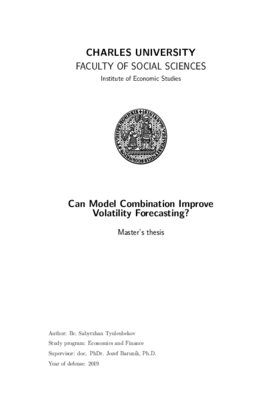Can Model Combination Improve Volatility Forecasting?
Může modelová kombinace řídit prognózu volatility?
diploma thesis (DEFENDED)

View/
Permanent link
http://hdl.handle.net/20.500.11956/110198Identifiers
Study Information System: 203074
Collections
- Kvalifikační práce [19618]
Author
Advisor
Referee
Červinka, Michal
Faculty / Institute
Faculty of Social Sciences
Discipline
Economics and Finance
Department
Institute of Economic Studies
Date of defense
16. 9. 2019
Publisher
Univerzita Karlova, Fakulta sociálních vědLanguage
English
Grade
Excellent
Keywords (Czech)
model combination, time series, volatility, forecast, machine learningKeywords (English)
model combination, time series, volatility, forecast, machine learningV současné době existuje řada metod predikce a prognostici čelí mnoha výzvám při výběru optimální metody pro predikci volatility. Tato diplomová práce testuje několik metod kombinací predikce, aby bylo možné využít široké škály prognóz. Bez ohledu na to, že existuje spousta literatury o kombinaci prognóz, kombinace tradičních metod s metodami machine learning je relativně vzácná. V této práci implementujeme následující kombinované metody: (1) simple mean forecast combination, (2) OLS combination, (3) ARIMA on OLS combined fit, (4) NNAR on OLS combined fit a (5) KNN regression on OLS combined fit. Na základě námi dostupných informací nejsou poslední dvě kombinované metody doposud zkoumány v akademické literatuře. Tato práce by navíc měla pomoci prognostici se třemi možnými komplikacemi: (1) výběr volatility proxy, (2) výběr měřítka přesnosti predikce a (3) výběr délky zkušebního vzurku. Zjistili jsme, že squared a absolute return proxy jsou mnohem méně účinné než Parkinson a Garman-Klass volatility proxy. Dále ukazujeme, že metriky přesnosti prognózy (RMSE, MAE nebo MAPE) ovlivňují pořadí optimálních prognóz. Dalším zjištěním je, že přestože kvalita predikce nezáleží na délce zkušebního vzorku, je vidět, že metody kombinace predikcí překonávají samostatné metody na delších zkušebních vzorcích. Na závěr jsme...
Nowadays, there is a wide range of forecasting methods and forecasters encounter several challenges during selection of an optimal method for volatility forecasting. In order to make use of wide selection of forecasts, this thesis tests multiple forecast combination methods. Notwithstanding, there exists a plethora of forecast combination literature, combination of traditional methods with machine learning methods is relatively rare. We implement the following combination techniques: (1) simple mean forecast combination, (2) OLS combination, (3) ARIMA on OLS combined fit, (4) NNAR on OLS combined fit and (5) KNN regression on OLS combined fit. To our best knowledge, the latter two combination techniques are not yet researched in academic literature. Additionally, this thesis should help a forecaster with three choice complication causes: (1) choice of volatility proxy, (2) choice of forecast accuracy measure and (3) choice of training sample length. We found that squared and absolute return volatility proxies are much less efficient than Parkinson and Garman-Klass volatility proxies. Likewise, we show that forecast accuracy measure (RMSE, MAE or MAPE) influences optimal forecasts ranking. Finally, we found that though forecast quality does not depend on training sample length, we see that forecast...
